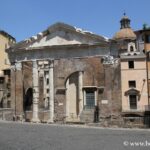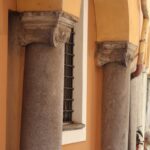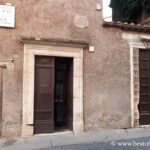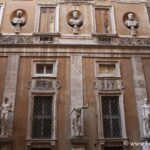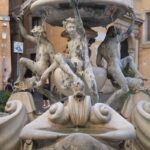The Ghetto: a Pleasant Neighborhood
The Jewish Ghetto of Rome is now a small, pleasant district nestled within the vast historic center of the city. It stands out for its village-like atmosphere, quieter and more intimate than the surrounding areas. Today, it corresponds to the Rione Sant’Angelo, stretching between Largo Argentina square—where a sanctuary dating back to Rome’s origins still remains—and the Theatre of Marcellus, then between the Tiber River and Piazza Venezia.
The visit to the Jewish Ghetto of Rome and Tiber Island ranks 15th in our Top 30 places to see in Rome.
The History of the District and the Jewish Heritage
This area of Rome bears the traces of the historic ghetto, where Jews were forced to live for nearly three centuries, from 1555 to 1870, under papal decree. At that time, the neighborhood was made up of large, unhealthy buildings, often flooded by the Tiber, connected by suspended bridges above narrow alleyways. Few remains of that period survive, as the area was completely redeveloped at the end of the 19th century, giving way to more open and pleasant spaces. A fragment of wall and some old gates still recall this enclosure.
Despite these transformations, Jewish culture continues to permeate the area. It is found in the local dialect and cuisine, with specialties such as fried artichokes, fish soup, and traditional pastries.
Exploring and Visiting the Ghetto
The streets of the ghetto host many small, typical bars and restaurants, appreciated by both locals and visitors.
Beyond its charming streets, the area reveals beautiful artistic and architectural works, including medieval portico columns embedded in facades. Piazza Mattei features the renowned Turtle Fountain, created in the 16th century by Taddeo Landini, and the Mattei Palace, whose two surprising inner courtyards are adorned with busts of Roman emperors and antiques. Further on, near the Capitoline Hill, a portion of the ancient Portico of Octavia, dating to the 2nd century BCE, stands next to the Theatre of Marcellus, forming a major archaeological site. Near the Tiber, the Great Synagogue, built between 1901 and 1904, stands out for its architecture and houses the Jewish Museum. Finally, Piazza Margana preserves well-maintained medieval elements.
Suggested Itinerary
For a west-to-east tour, start at Piazza Cenci, then walk along Via di Monte de’ Cenci to Piazza delle Cinque Scole. Continue on via del Portico d’Ottavia, then visit the Tempietto del Carmelo before reaching Piazza Mattei with its fountain and palace. Proceed to the Portico of Octavia, the Synagogue, the Theatre of Marcellus, then Piazza di Campitelli with its fountain and church. Finish at the picturesque Piazza Margana.
Remnants of the Old Ghetto
Historically speaking, this is where the popes decided to confine the Jews by walling off a large portion of this district, designated as the ghetto, for more than 300 years, from 1555 to 1870, almost without interruption. Only a section of the wall remains, along with a few passageways corresponding to the old gates.
Hotels and Accommodation near the Jewish Ghetto of Rome
Ideas for Visiting the Jewish Ghetto of Rome
Photo Gallery of the District
- Great synagogue
- Streets of the ghetto
- Via Margana
- Palazzo Mattei di Giove
- Fountain of the Turtles
Map of the Jewish Ghetto of Rome
If you see this after your page is loaded completely, leafletJS files are missing.










